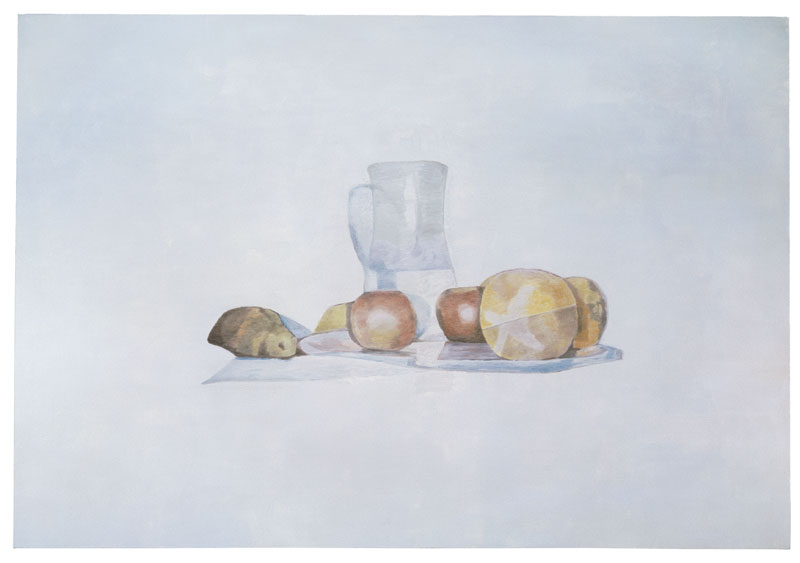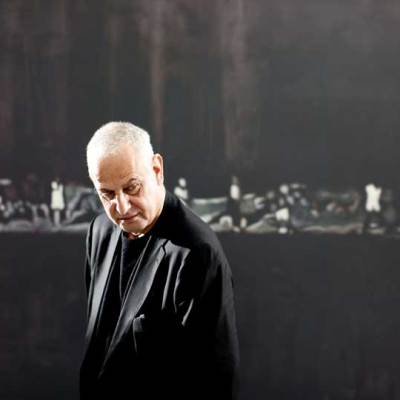This article was first published in the October 2014 issue of Apollo. Click here to subscribe to the magazine
One of the most influential painters working today, Belgian artist Luc Tuymans traces his roots to a Flemish tradition that reaches back to Van Eyck. His understated, often ambiguous works are difficult to pin down, yet as he tells Apollo, they are always attempts to engage with the world
Luc Tuymans (b. 1958) is among the pre-eminent painters of our image-saturated, multimedia age. His paintings, typically derived from pre-existing imagery including photographs and film stills, are characterised by their understated, cool appraisal of history, power and memory. The superficial banality of these appropriated pictures is laced with darker implications: the skier collapsed ruefully into the snow in Der Architekt (1998) is Albert Speer, captured in a home movie; paintings from the Allo! suite of 2012 translate stills from a film about the life of Paul Gauguin, obliquely critiquing art’s tendency to exoticise other cultures. The artist is here glimpsed as a shadow, his reflection caught in photographs of the film and now transmuted into paint.
The reliance on secondary sources sets these images at one remove, an impression that is heightened by the graceful formal properties of Tuymans’ distinctive style. In stark contrast to the heavily layered style of other European painters to have emerged in the post-war period, such as Georg Baselitz, Anselm Kiefer or the squeegee paintings of Gerhard Richter, his brushstrokes are delicate, light, transient. His canvases seem to linger on the point of fading into non-existence, as if slipping from recall, and often give the impression of a screen having been inserted between the image and its witness, conclusively separating us from it. The complexity of these paintings, their embrace of ambiguity and detachment, is at odds with the prevailing shift towards the iconic, the graphic and the sensational in contemporary image production, and is among the reasons that Tuymans is revered by his peers.
We meet at the artist’s studio in Antwerp, the city, he tells me, ‘of smartasses and troublemakers’. There is something of the two in Tuymans, whose bluff manner and imposing stature suggest a personality unlikely to suffer fools gladly, but whose intelligence and curiosity come to the fore in his sharp, wide-ranging discussion of literature, art and politics. He has always worked in Antwerp, partly because he appreciates the relative freedom from art world harassment that it affords him, yet also because he is clearly attached to a place that is not only his own home, but an eminent seat of painting.
It is a tradition to which he is indebted, to which he belongs, and from which he cannot escape. ‘Unluckily for Belgian painters,’ he says, ‘this country created the most powerful one of all, Jan van Eyck. After him, it’s all dilettantism.’ Yet the defining feature of Flemish and latterly Belgian painting is, according to Tuymans, its preoccupation with realism. A realism that can incorporate René Magritte (‘who was not a Surrealist, despite what people say’) and James Ensor is clearly not the kitchen-sink kind, and Tuymans describes an approach defined by the artist’s decision to take inspiration from the world around him and his place in it. This is ‘a realism born of necessity. This country has been overrun by so many foreign powers that we don’t have time to be Romantic.’
The upshot is that Tuymans ‘decided very early on not to make art from art’. Rather than join with, or react against, prevailing movements in the practice and theorisation of contemporary art he sought instead to engage with the world as he perceived it, and the impulse remains ‘to start from something real’. In the early part of his career he, like other continental painters of his generation, took the traumatic legacy of the Second World War as a subject. The war, he says, was the cause of Europe’s ‘psychological breakdown’, and its consequences remain, even today, only partially understood. The literal and symbolic opacity of paintings such as the Recherches triptych (1989), the innocuous domestic fixtures of which are relics of Auschwitz and Buchenwald, are a reflection of the fact that this trauma, like any other, can never be entirely explained away. It can only be exposed to light, and even then under controlled conditions.
It makes sense, in this context, that a Belgian artist should resist easy sloganeering and moralism; Tuymans’ paintings foreground polyvalence and doubt. Yet after his presentation for the Belgian Pavilion at the 2001 Venice Biennale, a series taking as a starting point the history of Belgian imperial rule in the Congo and the murder of Patrice Lumumba, he was labelled a political artist. It is a title he hotly resists: ‘I don’t think that an artist can be political, without formulating propaganda.’ A painting should not strive to communicate a pre-determined moral standpoint, then, but might encourage the viewer to reconsider theirs. The correspondence of overtness with tyranny is best enacted in that masterpiece of propaganda, Jacques-Louis David’s Death of Marat (1792), described by Tuymans as ‘a falsification of history and the most diabolic use of power that I can think of. Which does not,’ he ruefully acknowledges, ‘mean it isn’t interesting.’
Tuymans made what was widely read as a conscious effort to cast off the label he so mistrusted when, the following year, he was invited to show at Documenta 11. In the wake of the September 11 attacks on New York, he confounded expectations that he would produce a history painting on the subject by instead unveiling his monumental Still Life (2002). The gesture seemed to acknowledge the inadequacy of art in respect of the grand themes, and was interpreted in some quarters as almost a shirking of responsibility. Tuymans rebuts the latter charge, while qualifying the former. ‘My wife and I were there during 9/11. We saw the planes going into the buildings from our hotel room. I thought it was impossible to do something with the event at that time. It’s not the way that painting works.’ Instead he elected to take the opposite approach from that expected of him (a symptom, I suspect, of a more general contrarianism), and produce a work from the ‘lowest rung on the painterly hierarchy, a still life’. If at the time the work felt deflationary, it has since earned the status of a quiet triumph, a rare moment of reflection and stillness during a febrile period in which, in retrospect, rashness was allowed to predominate. ‘Painting,’ this great painter tells me, ‘is an anachronism. It will always be that way. But it has never been naïve.’
What, then, is the way that painting works? Tuymans’ method is a curious one. It takes two stages, the first comprising a lengthy period of gestation in which an image and an idea gain shape. This contemplative phase can last months, even years, and is ‘the most painful part of the process’. Images are tested and reconsidered, with Tuymans sometimes using computer programmes to alter them digitally to his satisfaction, or maquettes to realise them in space. Following this comes a burst of intense physical activity in which the finalised image is translated onto the canvas. Remarkably, Tuymans states that most of his canvases are completed in a single day. ‘When I paint I don’t want to think any more. My intelligence shifts from my brain to my hand. It becomes an intense bodily act. When I close the door on my studio at the end of the day I have to be convinced that the painting has worked. Then I go drinking. I come back to the studio, still somewhat under the influence, in the morning, because that allows me to see the work with the eyes of a stranger, which is every artist’s dream. I know then if anything further needs to be done.’
One notices, talking to Tuymans, how little distinction he makes between contemporary and canonical art, expressing admiration for Takashi Murakami alongside his veneration of Van Eyck. That broadmindedness, and determination to uncover connections, is evident in his practice as an occasional curator, notably in ‘The State of Things: Brussels/Beijing’ (with Ai Weiwei; 2009–10), which began at the BOZAR before travelling to the National Art Museum of China, and the 2013 exhibition, ‘Constable, Delacroix, Friedrich, Goya: A Shock to the Senses’ (with Ulrich Bischoff), at the Albertinum, Dresden. In 2015, Tuymans will curate an exhibition of paintings across the two floors of London’s Parasol unit foundation for contemporary art. Comprising six painters of varying ages and nationalities, Tuymans describes the motivating principle as being the ‘juxtaposition of different lines of thought’.
There are obvious similarities between this multilayered approach to the organisation of an exhibition and Tuymans’ own painterly methodology. This policy is ‘especially important in London’, he says, where the prevailing attitude towards the presentation of contemporary art is one that promotes something like a confrontation between the viewer and the artwork. ‘Painting is more than a visceral, one-on-one situation; it is much more complex than that.’ The show at Parasol unit, then, will be a ‘show to be seen as a whole, rather than a collection of isolated paintings’. Tuymans’ sympathy for the project undertaken by Ziba Ardalan at Parasol unit – a not-for-profit institution that provides a much-needed space outside the market for the promotion of young artists – is evident in his contribution to ‘Towards Tomorrow’, the charity art auction in collaboration with Sotheby’s and Paddle8 marking the foundation’s 10th anniversary this autumn.
Despite his close involvement in exhibitions, Tuymans has no intention of entering ‘into conflict with curators or curatorial practice, because I think it’s an absolutely necessary discipline’. In fact, he says, ‘we need more museum people’ to counter the predominance of those whose curatorial practice is indistinguishable from ‘developing a network’. The artist is scathing, too, about the increasing commercialisation of the international art market and its pernicious effects on the development of young artists. The impulse to make one’s work available to a wider public is, he fears, among the casualties of the new order (Tuymans has always insisted that one third of his paintings be placed with public institutions and museums).
Rather than bark from the margins, however, Tuymans acknowledges a responsibility to ‘try to find a constructive approach to the way that art is made and shown today’. His status as an artist allows him the opportunity to work at a different speed to other curators, freed from the financial pressures that attend commercial galleries. This provides the space required for the subtle and complex to compete with the immediate and explicit, for viewers to develop their own interpretations rather than be provided with a pre-packaged one. The statement with which Tuymans closes our interview, then, seems neatly to encapsulate his combined approach to art’s creation, exhibition and reception: ‘Without generosity there is no art. I am convinced of that.’
Ben Eastham is co-founder and editor of The White Review.








